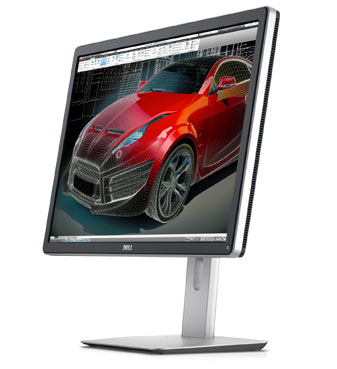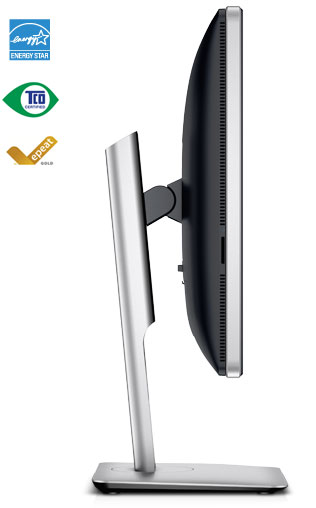Dell Leaks Details of a 24” UHD 4K (3840x2160) Monitor, the UP2414Q
by Ian Cutress on December 1, 2013 12:01 PM EST
Currently there are several 4K options on the market – models using the higher end IGZO displays such as the Dell Ultrasharp 32” 4K (UP3214Q, $3500) or the ASUS PQ321Q ($3500, our review) are currently attracting the most attention. From my perspective (and a few others), 32” is just too large for a desktop monitor and while 4K seems attractive, something smaller (27”) would be more palatable. In comes Dell, who has leaked through their Belize website, the next generation 24” UHD Monitor, the UP2414Q. (Interesting enough it is also mentioned on their US website, through the compatibility list of a sound bar.)

Putting arguments aside about OS scaling and whether someone needs 4K in a 24 inch monitor, the specifications do make for interesting reading:
- 3840 x 2160 in 24 inches = 183.58 pixels per inch, compared to 204 for the IBM T220/T221 and 137.6 for a 32” UHD
- 178º/178º Viewing Angle
- 99% AdobeRGB and 100% sRGB (G-B LED backlight we assume)
- Factory Calibrated to Delta-E < 2
- 10-bit, 1.07 billion colors
- HDMI, DisplayPort, mini-DP, four USB 3.0 and 6-in-1 card reader

Of course, information is limited. Other reports online list this as an IPS panel, although that is ultimately unverifiable at this point in time - we can only speculate that a 24" high end panel is finally making its way through the chain. The 32” UP3214Q from Dell is only 30Hz at full resolution unless you use DisplayPort 1.2a + MST (Chris is testing this monitor as I type), so one might assume that the 24” panel would be the same.
Price and release date not announced – given that the 32” models are around $3500, the offset of a smaller cut of panel against the increased difficulty in creating it might be the competing factors here.
Update: We have some information, direct from Dell's new US website page for the UP2414Q:
Display
Diagonally Viewable Size:
60.47 cm
23.8" (23.8-inch wide viewable image size)
Aspect Ratio:
Widescreen (16:9)
Panel Type, Surface:
In-plane switching, anti glare with hard coat 3H
Optimal resolution:
3840 x 21601 at 60 Hz (DP1.2*)
3840 x 21601 at 30 Hz HDMI
Contrast Ratio:
1000: 1 (typical)
2 Million:1 (Max) (Dynamic Contrast Ratio)
Brightness:
350 cd/m2 (typical)
Response Time:
8 ms (gray to gray)
Viewing Angle:
(178° vertical / 178° horizontal)
Color Support:
Color Gamut (typical): Adobe RGB 99%, sRGB 100%
1.07 Billion colors (8 Bits +AFRC)
Pixel Pitch:
0.137 mm
Pixel Per Inch (PPI):
185
Backlight Technology:
LED
Display Type:
Widescreen Flat Panel Display
Display Screen Coating:
Antiglare with hard-coating 3H
|
Connectivity
1 HDMI connector
1 Mini DisplayPort
1 DisplayPort (version 1.2a)
4 USB 3.0 ports - Downstream (4 at the back, 1 with battery charging)
1 USB 3.0 port - Upstream
1 Media Card Reader
Stand
Height-adjustable stand, tilt, swivel, pivot and built in cable-management
Flat Panel Mount Interface:
VESA (100 mm)
Built-in Devices
USB 3.0 Hi-Speed Hub (with 1 USB upstream port and 4 USB downstream ports)
Size and Weight
Dimensions with stand (H x W x D):
14.61" ~ 19.75" (371.1 mm ~ 501.7 mm) x 22.40" (569.0 mm) x 7.56" (192.0 mm)
Dimensions without stand (H x W x D):
13.33" (338.5 mm) x 22.40" (569.0 mm) x 2.22" (56.3 mm)
Preset Display Area(H X V):
527.04 mm x 296.46 mm
20.7" x 11.7"
Weight (panel only - for VESA mount):
4.8 kg (10.58 lbs)
Weight (with packaging):
10.0 kg (22.05 lbs)
|
Update 2: Pricing has just been announced due to an official Dell press release:
Availability and Pricing
The Dell UltraSharp 32 Ultra HD Monitor (UP3214Q) is available globally starting at $3,499. The Dell UltraSharp 24 Ultra HD Monitor (UP2414Q) is now available in the Americas, starting at $1,399. It will be available worldwide on December 16. The UltraSharp 28 Ultra HD Monitor (P2815Q) will be available in early 2014.
$1400 ?! Can I sign up for a few? That matches the recent batch of IBM T221 models that were sold on ebay this year. For a long while we were expecting some pricing north of $2500, but at $1400 I am actually amazed.










60 Comments
View All Comments
Crisium - Sunday, December 1, 2013 - link
I think 27" is the sweet spot, so it's nice to see monitors on both sides of that target. It means we will see 27" in time.2160 available between 24-31.5" gives a lot of flexibility. You have a big desk and sit faraway, get a 31.5". You have a small desk, sit close, or simply value PPI over anything else, get a 24". And get the 27" for the balanced approach. Assuming we get 27", in time.
Also, what's with everyone falling for marketing? 32-inch displays are like fairy dust. Do you actually think they exist? Please, call them 31.5". Lest we call 21.5" displays 22" all of a sudden. They advertise 31.5" TVs as 32" too the masses. We are enthusiasts, lets act like it and be accurate in our discussions.
r3loaded - Sunday, December 1, 2013 - link
24 inches would be perfect. You can simply scale everything to 200% and it'll look perfectly right. Plus I won't have the awkward situation where a 13-inch rMBP has a higher resolution than my 22-inch desktop monitor.Mr Majestyk - Sunday, December 1, 2013 - link
I'm not sure I'd feel the need to get a 24" monitor with this resolution. I'd much prefer 2560 x 1600 in a 24" monitor, but for 27" definitely want 4K for sure. We are seeing 13.3" laptops with 2880 x 1800 and 3200 x 1800 and it'd be nice to see these resolutions filter into the 21-27" monitor size as well.I can't see this 24" 4K monitor coming in under $1500 at this stage, however. I'll be in no rush to upgrade even though for my photo work 4K would be perfect, I'm not paying more than $1K for 27" monitors and also I'll wait until GPU's can do 4K hardware acceleration etc
peterfares - Sunday, December 1, 2013 - link
The reason UHD is nice for 24" is because you can run it at 200% scaling. Older DPI-unaware programs won't look bad because they're being scaled by a factor of 2 in each direction. A 2560x1600 24" monitor would need 150% scaling or so, making older programs look bad because they're being scaled by 1.5.darckhart - Sunday, December 1, 2013 - link
I believe the spec listed on the dell leak says it's going to be an AH-IPS panel. can't find the link at the moment.Geekzilla - Sunday, December 1, 2013 - link
I'm disappointed that this is 16:9. 16:10 is superior for productivity.Sancus - Sunday, December 1, 2013 - link
32" is a good size for a 4k desktop monitor because applications are still easily readable at normal viewing distance without scaling tricks. Given that OS-level scaling is still a complete disaster on Windows, this is a pretty big barrier to adoption for super high dpi monitors on platforms other than OSX.peterfares - Sunday, December 1, 2013 - link
LOL when was the last time you used Windows scaling? XP? Windows supports scaling fine. Many third party programs don't, but Windows does. And a UHD 24" would run at 200% so programs that don't support scaling can just be stretched to 200% and not look like crap.Sancus - Sunday, December 1, 2013 - link
Last time I used it was in Windows 8.1, where it's still completely broken with many apps. "Many third party programs" such as Skype don't scale at all regardless of your settings.madmilk - Monday, December 2, 2013 - link
It's still pretty broken as of 8.1 in desktop mode, especially with multiple monitors of different PPI. Even built-in programs function extremely poorly there, with strange rescaling and mismatched sizes on things like wallpapers and the desktop toolbar. Scaling options are also extremely limited with multiple monitors, since for some reason Microsoft decided to provide only one global setting for scaling, which is then multiplied by a preset factor for each monitor derived from its PPI. Might be nice in theory, but using the equivalent of 1440x900 on a 15.4" rMBP screen is a huge waste of pixels. I can't turn down the global scaling factor, since then everything on my regular 96PPI desktop screen becomes smaller and therefore blurry.